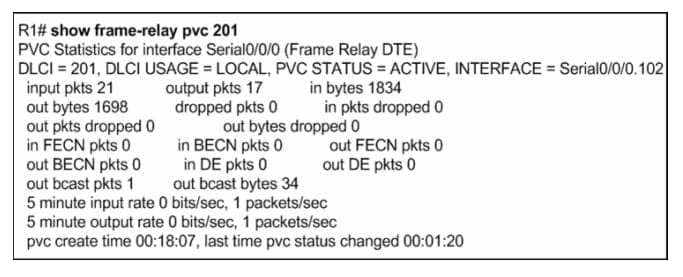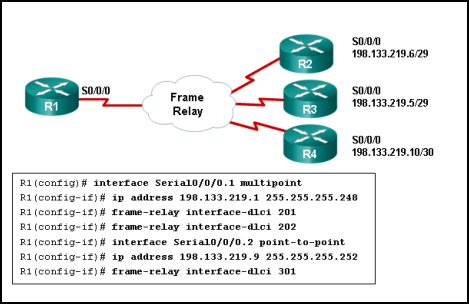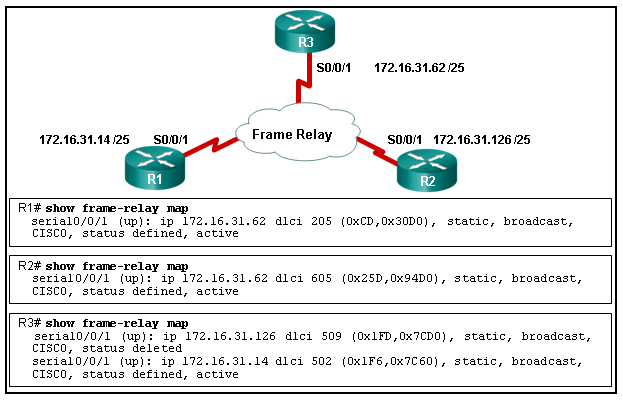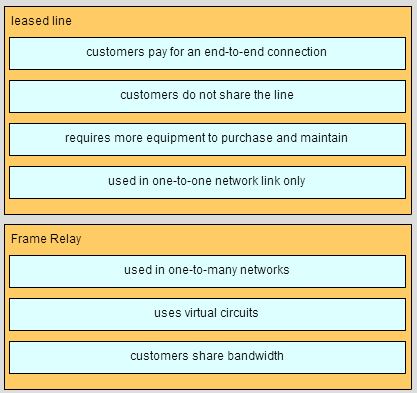Last Updated on May 3, 2018 by Admin
CCNA 4 Chapter 4
From year to year, Cisco has updated many versions with difference questions. The latest version is version 6.0 in 2018. What is your version? It depends on your instructor creating your class. We recommend you to go thought all version if you are not clear. While you take online test with netacad.com, You may get random questions from all version. Each version have 1 to 10 different questions or more. After you review all questions, You should practice with our online test system by go to "Online Test" link below.
-
What is a characteristic of Frame Relay that provides more flexibility than a dedicated line?
- Dedicated physical circuits are installed between each site.
- Customers use dedicated circuits in increments of 64 kb/s.
- The Frame Relay cloud allocates as much bandwidth as required to active PVCs to maintain the connection.
- One router WAN port can be used to connect to multiple destinations.
-
What are the two major criteria that constitute the cost of a Frame Relay circuit? (Choose two.)
- circuit management fees
- local loop
- end-to-end connectivity
- required bandwidth
- QoS
-
A router interface connects to a Frame Relay network over a preconfigured logical circuit that does not have a direct electrical connection from end to end. Which type of circuit is being used?
- SVC
- full mesh
- PVC
- hub and spoke
- dedicated leased line
-
Which Frame Relay topology provides a connection from every site to every other site and maintains a high amount of reliability?
- partial mesh
- full mesh
- star
- hub and spoke
-
Which technology allows a Layer 3 IPv4 address to be dynamically obtained from a Layer 2 DLCI?
- Inverse Address Resolution Protocol
- Inverse Neighbor Discovery
- Address Resolution Protocol
- Neighbor Discovery
-
A network administrator has statically configured the LMI type on the interface of a Cisco router that is running Cisco IOS Release 11.2. If the service provider modifies its own LMI type in the future, what step must the network administrator take?
- The network administrator must modify the keepalive time interval to maintain connectivity with the LMI type of the service provider.
- The network administrator simply has to verify connectivity with the provider, because the router has an LMI autosensing feature that automatically detects the LMI type.
- The network administrator must statically set the LMI type to be compatible with the service provider.
- The network administrator does not have to do anything, because all LMI types are compatible with one another.
-
Which two functions are provided by the Local Management Interface (LMI) that is used in Frame Relay networks? (Choose two.)
- simple flow control
- error notification
- congestion notification
- mapping of DLCIs to network addresses
- exchange of information about the status of virtual circuits
-
Which parameter would be specified in a Frame Relay provider contract for a particular company?
- CIR
- DE
- Inverse ARP enabled/disabled
- QoS
-
Which three notification mechanisms are used when congestion is present in a Frame Relay network? (Choose three.)
- BECN
- CIR
- DE
- DLCI
- FECN
- inverse ARP
-
Why would a customer request a Frame Relay circuit with a CIR of zero?
- to have better QoS
- to have a backup circuit for critical data transmissions
- to have a link with reduced costs
- to have a circuit used for voice traffic
- to have a circuit used for network management traffic
-
Which provider-negotiated parameter would allow a customer to send data above the rate of the bandwidth specified by the CIR?
- Bc
- DE
- Be
- FECN
-
What is the purpose of applying the command frame-relay map ip 10.10.1.2 110 broadcast?
- to configure a device with a static Frame Relay map that also allows the forwarding of routing updates
- to allow Frame Relay frames to be broadcast on all Frame Relay interfaces
- to allow Frame Relay frames to be broadcast toward host 10.10.1.2
- to allow Frame Relay frames to be broadcast over DLCI 110
- to support IPv6 traffic over the NBMA network by using DLCI 110
-
Refer to the exhibit. Which two statements are correct? (Choose two.)
- The Frame Relay map was set by using the command frame-relay map.
- The DLCI that is attached to the VC on RB to RA is 62.
- The IPv4 address of interface S0/1/0 on RA is 192.168.1.2.
- The DLCI that is attached to the VC on RA to RB is 62.
- The IPv4 address of interface S0/1/1 on RB is 192.168.1.2.
-
Refer to the exhibit. Which statement is true about Frame Relay traffic on R1?
- Traffic that is mapped to DLCI 201 will exit subinterface Serial 0/0/0.201.
- Traffic that exits subinterface Serial 0/0/0.102 is marked with DLCI 201.
- Traffic on Serial 0/0/0 is experiencing congestion between R1 and the Frame Switch.
- Frames that enter router R1 from a Frame Relay neighbor will have DLCI 201 in the frame header.
-
Which three actions can be taken to solve Layer 3 routing protocol router reachability issues when using Frame Relay? (Choose three.)
- Use subinterfaces.
- Disable Inverse ARP.
- Disable split horizon.
- Use a full mesh topology.
- Configure static DLCI mappings.
- Use the keyword cisco as the LMI type.
-
When would the multipoint keyword be used in Frame Relay PVCs configuration?
- when global DLCIs are in use
- when using physical interfaces
- when multicasts must be supported
- when participating routers are in the same subnet
-
A network engineer has issued the interface serial 0/0/1.102 point-to-point command on a router that will be communicating with another router over a Frame Relay virtual circuit that is identified by the DLCI 102. Which two commands would be appropriate for the network engineer to issue next? (Choose two.)
- no ip address
- no shutdown
- encapsulation frame relay
- frame-relay interface-dlci 102
- ip address 10.1.1.10 255.255.255.252
-
Which two Frame Relay router reachability issues are resolved by configuring logical subinterfaces? (Choose two.)
- Frame Relay is unable to map a remote IP address to a DLCI.
- Link-state routing protocols are unable to complete neighbor discovery.
- LMI status inquiry messages sent to the network are not received.
- Inverse ARP fails to associate all IP addresses to the correct DLCIs.
- Distance vector routing protocols are unable to forward routing updates back out the incoming interface to other remote routers.
-
Refer to the exhibit. A network administrator has implemented the show interfaces serial 0/1/0 command. What can be verified from the displayed output?
- Router R1 connects to multiple sites through the serial 0/1/0 interface.
- Router R1 is not using the default LMI type.
- Router R1 is forwarding traffic on interface serial 0/1/0 using the local DLCI 1023.
- Router R1 has been configured with Frame Relay via the ietf keyword.
-
The show frame-relay pvc command is best utilized to display the number for which type of packets that are received by the router?
- LMI status messages
- Inverse ARP messages
- Inverse Neighbor Discovery messages
- FECN and BECN messages
-
Refer to the exhibit. A network administrator is configuring Frame Relay subinterfaces on R1. A distance vector routing protocol has also been configured. Data is routing successfully from R1 to networks that are connected to R2, R3, and R4, but routing updates between R2 and R3 are failing. What is the possible cause of this failure?
- Subinterfaces cannot be used on multipoint Frame Relay links.
- Two DLCI identifiers cannot be configured on one subinterface.
- Multipoint Frame Relay networks cannot be used with this IP addressing scheme.
- Split horizon is preventing successful routing table updates on the multipoint link.
-
Refer to the exhibit. A network administrator issues the show frame-relay map command to troubleshoot the Frame Relay connection problem. Based on the output, what is the possible cause of the problem?
- The S0/0/1 interface of the R2 router is down.
- The IP address on S0/0/1 of R3 is configured incorrectly.
- Inverse ARP is providing false information to the R1 router.
- The Frame Relay map statement on the R3 router for the PVC to R2 is configured with an incorrect DLCI number.
- The S0/0/1 interface of the R2 router has been configured with the encapsulation frame relay ietf command.
-
Fill in the blank. Use an acronym.
The Frame Relay DLCI identifies a connection from one endpoint to a remote destination.
-
Fill in the blank.
The encapsulation frame-relay ietf command enables Frame Relay encapsulation and allows connection to a device from a different vendor.
-
Match the characteristics with the type of WAN link. (Not all options are used.)
From year to year, Cisco has updated many versions with difference questions. The latest version is version 6.0 in 2018. What is your version? It depends on your instructor creating your class. We recommend you to go thought all version if you are not clear. While you take online test with netacad.com, You may get random questions from all version. Each version have 1 to 10 different questions or more. After you review all questions, You should practice with our online test system by go to "Online Test" link below.





